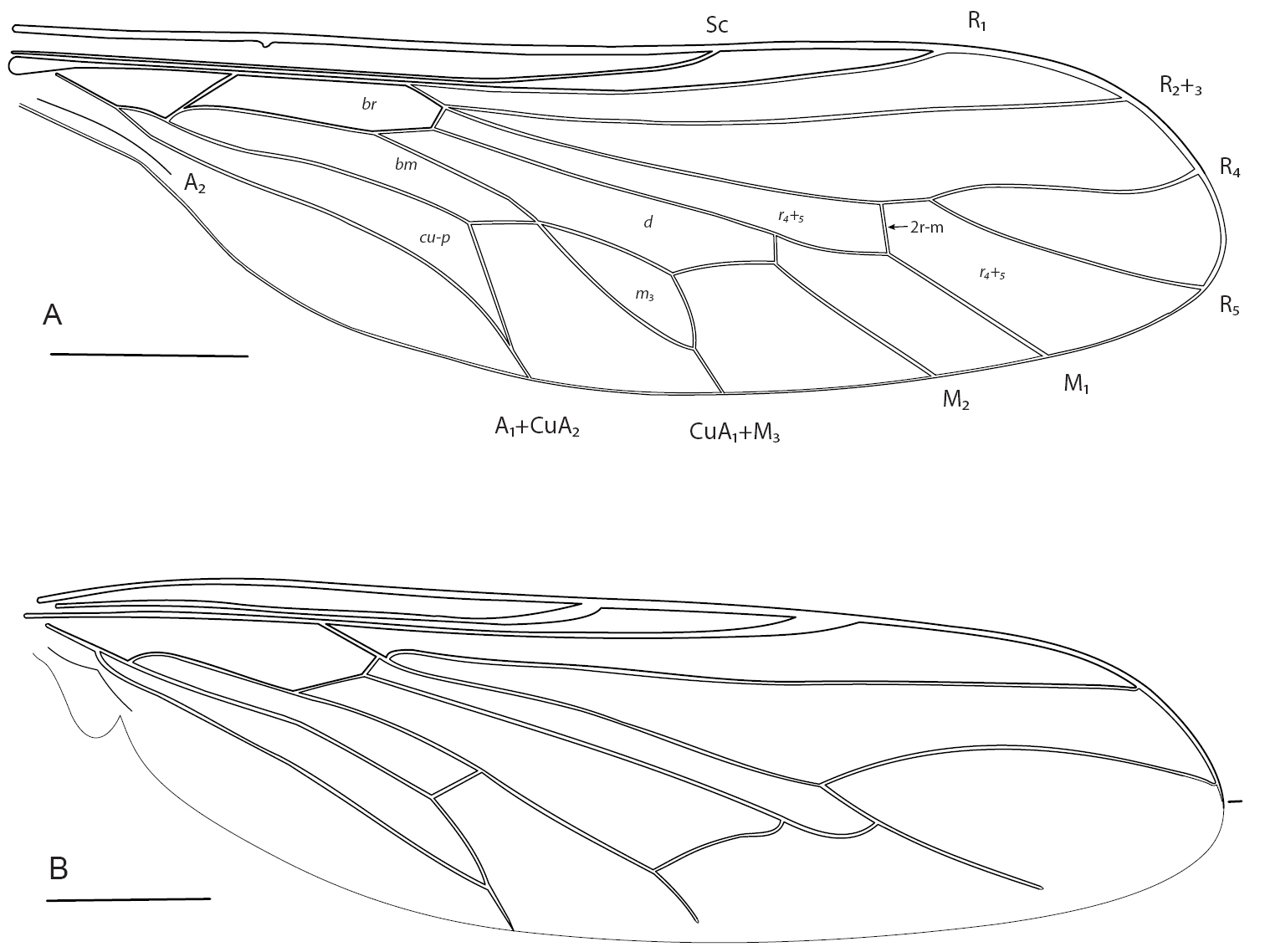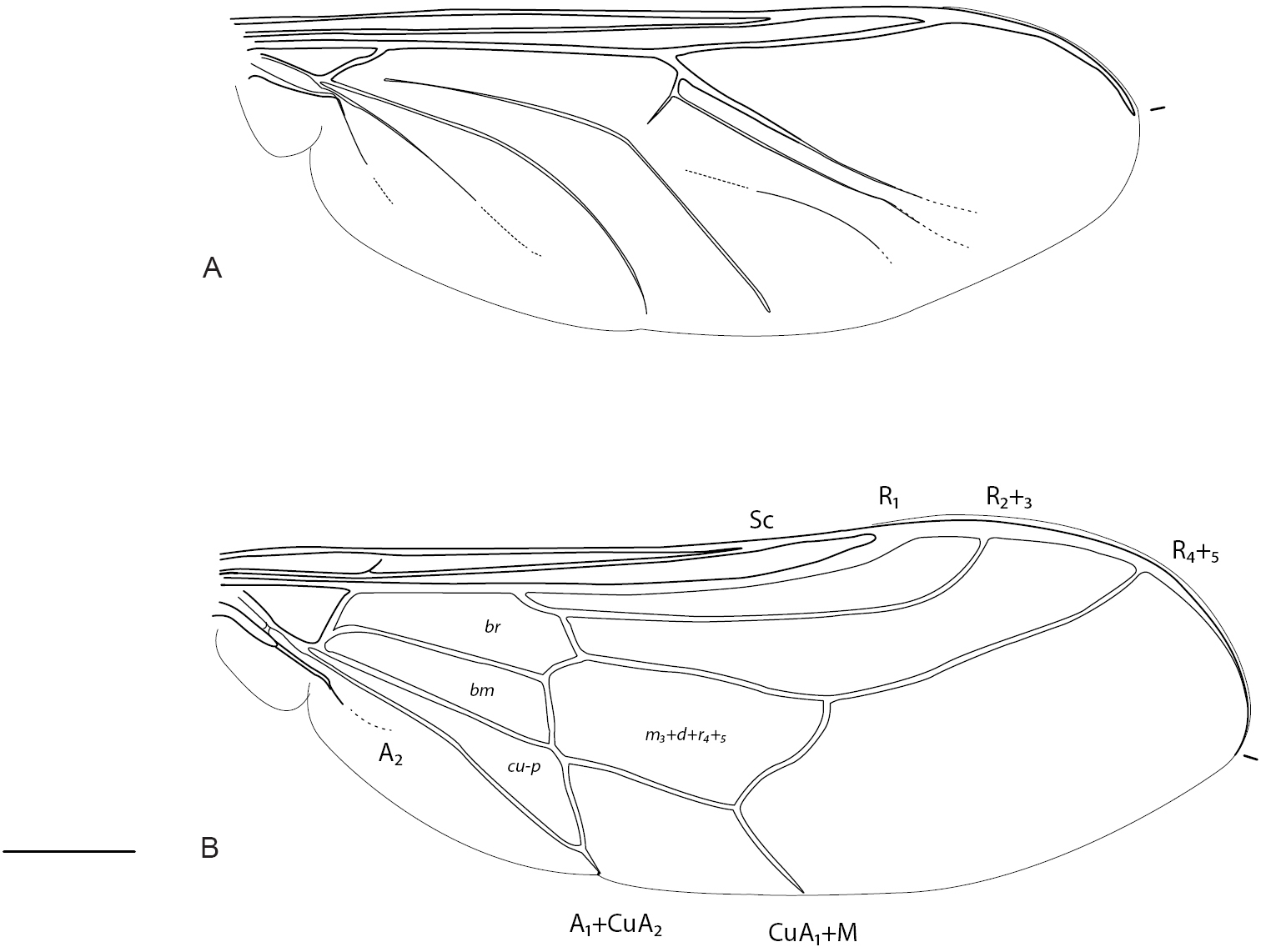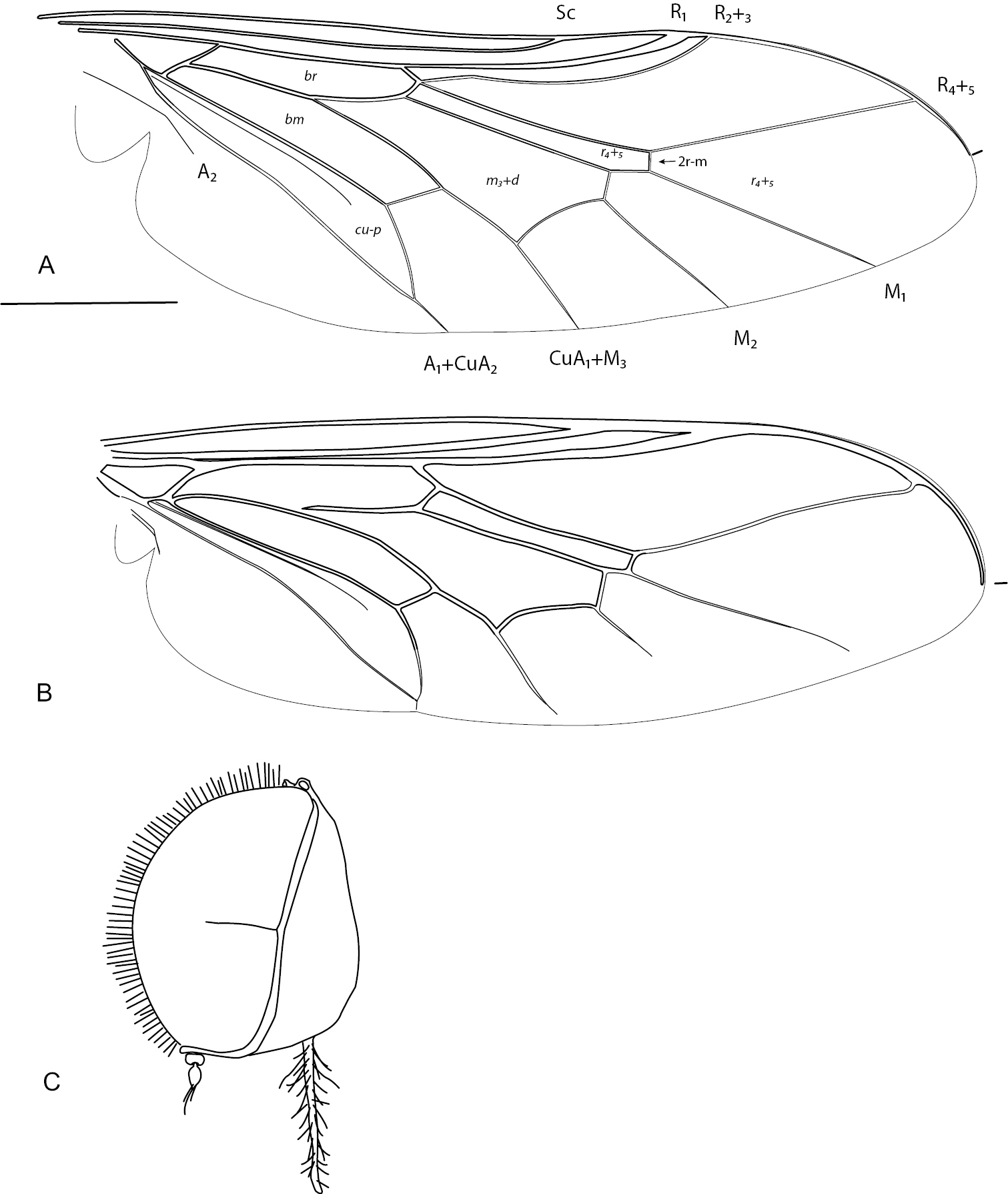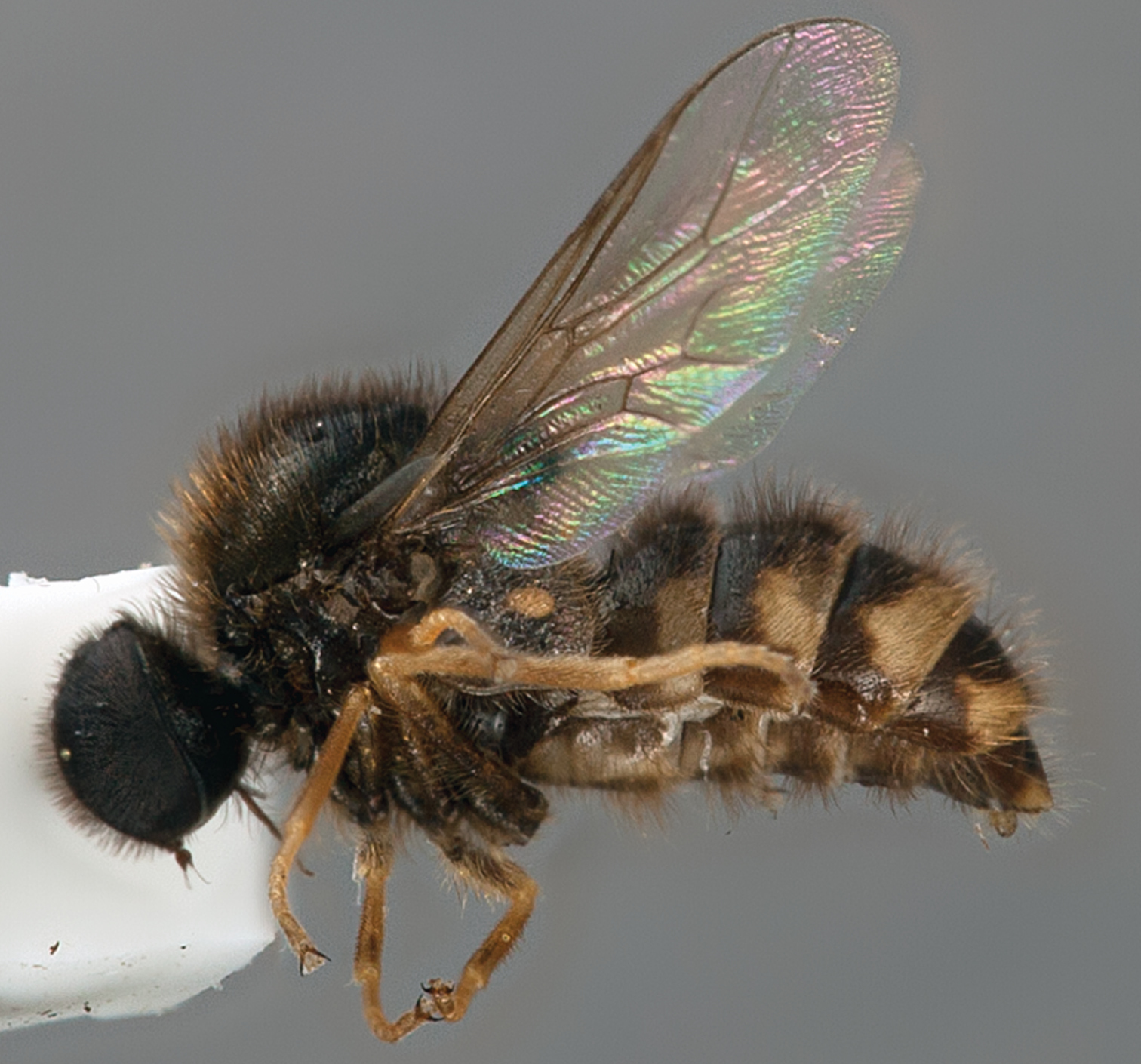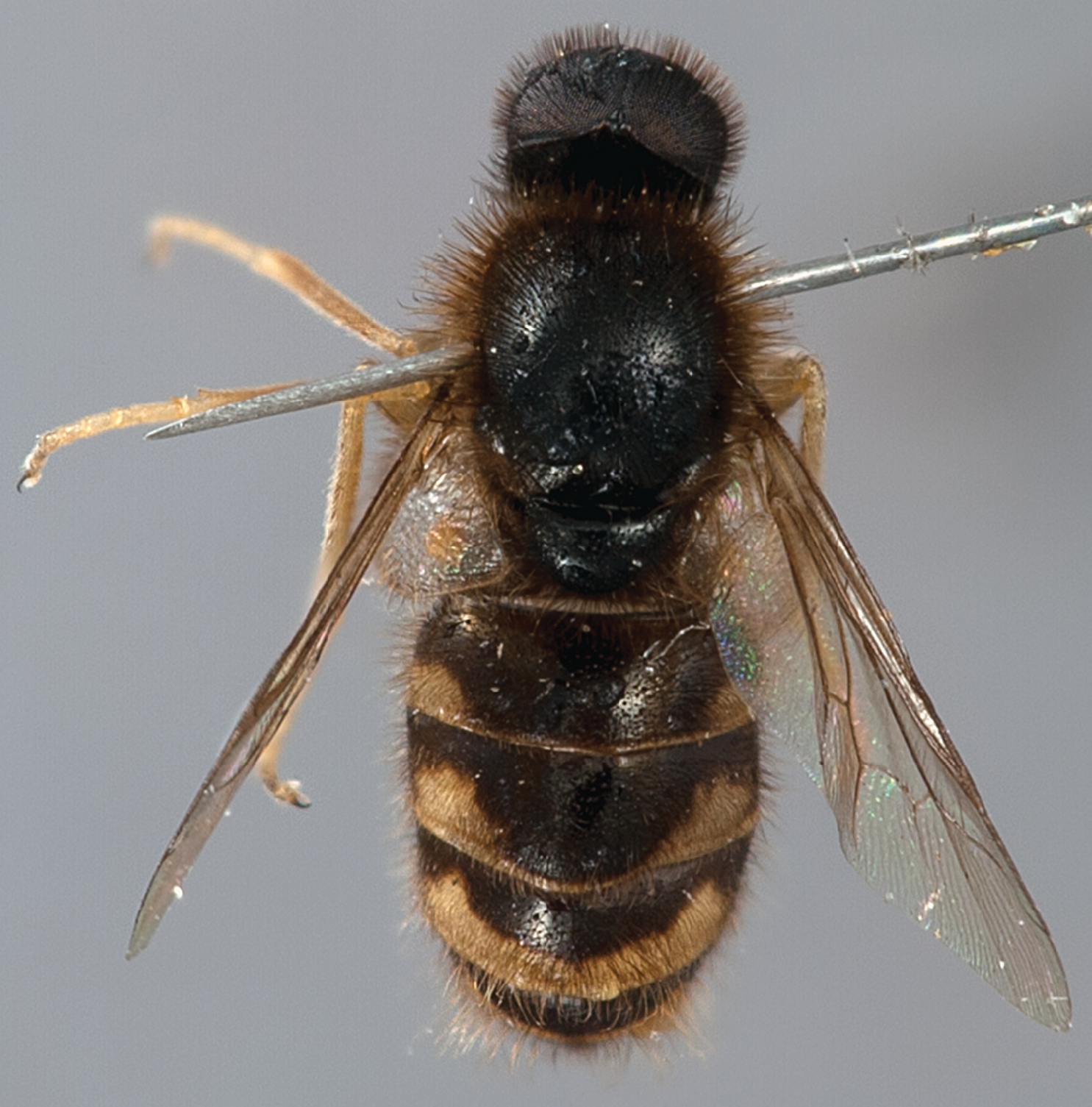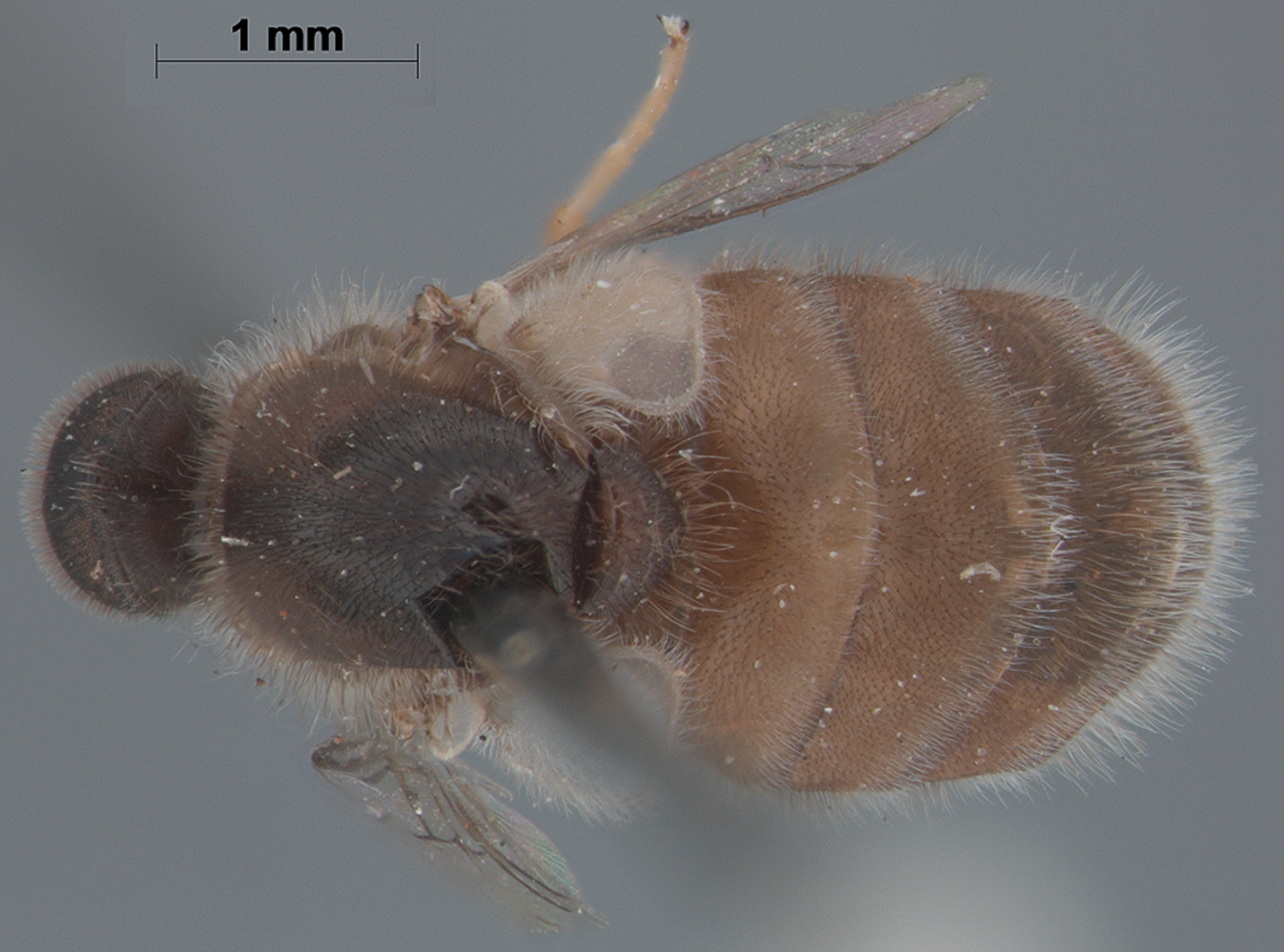






(C) 2012 Shaun L. Winterton. This is an open access article distributed under the terms of the Creative Commons Attribution License 3.0 (CC-BY), which permits unrestricted use, distribution, and reproduction in any medium, provided the original author and source are credited.
For reference, use of the paginated PDF or printed version of this article is recommended.
In this paper we diagnose the genus Sabroskya Schlinger, 1960 and describe Sabroskya schlingeri sp. n. from Malawi. We also provide dichotomous keys to species of Sabroskya and to world genera of the subfamily Acrocerinae, both extant and extinct.
Acroceridae, spider parasitoid
Spider flies (Diptera: Acroceridae) are a geographically cosmopolitan group although most species are relatively rarely collected. Adults have a distinctive morphology and a wide diversity of form, but typically with a small head, greatly enlarged lower calypter and swollen abdomen. Larvae are parasitoids of spiders, with a hypermetamorphic life cycle consisting of four instars (
Acroceridae comprise approximately 520 species in 53 genera (
Acrocerinae comprise 17 extant and 5 extinct described genera, found in all major biogeographical regions. The subfamily is distinguished from Philopotinae and Panopinae by the following characteristics: antennae styliform, postpronotal lobes widely separated, never medially contiguous, humeral crossvein rarely well developed, and tibial apical spines absent (rarely present) (
Six genera of Acrocerinae are known from the Afrotropical Region, including the nearly cosmopolitan genera Acrocera, Ogcodes and Pterodontia, as well as the endemic genera Psilodera, Meruia Sabrosky, 1950 and Sabroskya Schlinger, 1960. Sabroskya includes two previously described species from South Africa (Sabroskya ogcodoides Schlinger, 1960 and Sabroskya palpalis Barrclough, 1984) (
Terminology follows
The extinct genus Juracyrtus Nartshuk, 1996 is not included as it is represented by a compression fossil and lacks sufficient detail to be thoroughly differentiated from other genera. Two recently described genera, Schlingeromyia Grimaldi & Hauser, 2011 and Burmacyrtus Grimaldi & Hauser, 2011, from Cretaceous aged amber (
| 1 | Cell m3 present and well formed (Fig. 1A) | 2 |
| – | Cell m3 clearly absent (Figs 1B, 2–3), or, fusion of m3 with discal cell indicated by presence of spur veins (rare) | 10 |
| 2 | Antennae not adjacent to the ocellar tubercle; located on middle of frons, separated from ocellar tubercle by distance much greater than length of ocellar tubercle (Figs 3C, 5) | 3 |
| – | Antennae adjacent to the ocellar tubercle | 5 |
| 3 | Wing vein R4+5 forking from R2+3 in distal half of cell r4+5; cells bm and br fused into a single cell; cell r4+5 relatively broad; eye emarginate (Burmese Amber) | Schlingeromyia Grimaldi & Hauser, 2012 |
| – | Wing vein R4+5 forking from R2+3 before or at base of cell r4+5; cells bm and br separate; cell r4+5 relatively narrow along entire length; eye not emarginate | 4 |
| 4 | Eyes apilose; radial veins curved anteriorly, joining to anterior margin of wing (Southern Africa) | Psilodera Gray, 1832 |
| – | Eyes pilose; radial veins relatively straight, joining wing apex (Chile) | Holops Philippi, 1865 |
| 5 | Eyes very sparsely pilose, few microscopic setae present (India) | Subcyrtus Brunetti, 1926 |
| – | Eyes densely pilose | 6 |
| 6 | Mouthparts longer than head; palpi present; proboscis not pilose | 7 |
| – | Mouthparts shorter than head; palpi apparently not present; proboscis pilose (Fig. 3C) | 8 |
| 7 | Antennae separated form ocellar tubercle by small depression (Europe) (Fig. 1A [wing]) | Cyrtus Latreille, 1797 |
| – | Antennae not separated from ocellar tubercle by depression (China) | Paracyrtus Schlinger, 1972 |
| 8 | Mouthparts very short, barely protruding from oral cavity (Palaeartic) | Asopsebius Nartshuk, 1982 |
| – | Mouthparts longer, protruding from oral cavity, but not longer than head | 9 |
| 9 | Labellum present; abdominal spiracles II - IV placed in intersegmental membranes (Taiwan) | Hadrogaster Schlinger, 1972 |
| – | Labellum absent; abdominal spiracles II - IV placed in corresponding sternites (Taiwan and Japan) | Nipponcyrtus Schlinger, 1972 |
| 10 | Antennae located on upper half of head, usually proximal to ocellar tubercle | 11 |
| – | Antennae located on lower half of head, adjacent to oral cavity | 17 |
| 11 | Vein R4+5 represented as a single unforked vein | 12 |
| – | Veins R4 and R5 forked and petiolate basally (R4 rarely incomplete basally) | 14 |
| 12 | Eyes minutely pilose, setae barely evident; petiolate to wing margin; flagellum with minute terminal seta; male genitalic capsule enlarged and bulbous (Chile) (Fig. 1B) | Sphaerops Philippi, 1865 |
| – | Eyes clearly pilose; flagellum with relatively large terminal seta; male genitalic capsule not enlarged or bulbous | 13 |
| 13 | Microtrichia on the wing membrane absent; A1 joined to wing margin separate from CuA2 (Baltic Amber) | Villalites Hennig, 1966 |
| – | Microtrichia on the wing membrane present; A1 and CuA2 approximated distally but incomplete, not joined to wing margin (Chile) | Villalus Cole, 1918 |
| 14 | Wing with single medial vein (M3?); cell bm only well defined, other cells reduced or merged to form single cell open basally; alula well developed (most biogeographic regions) | Acrocera Meigen, 1803 |
| – | Wing with three medial veins originating from discal cell; wing with three or four wing cells well defined; alula present or absent | 15 |
| 15 | Mediolobus absent; crossvein 2r-m absent so that only three closed wing cells present; antennal style longer than rest of flagellum (Burmese Amber) | Burmacyrtus Grimaldi & Hauser, 2011 |
| – | Mediolobus present and similar shaped to pulvilli; crossvein 2r-m present so that four closed wing cells are present; antennal style shorter than rest of flagellum | 16 |
| 16 | Anterior ocellus reduced but present; costa circumambient; male wing with anterior costal process (Nearctic) | Turbopsebius Schlinger, 1972 |
| – | Anterior ocellus absent; costa ending in radial field near wing apex; male wing without anterior process (Palaearctic) | Opsebius Costa, 1855 |
| 17 | Wing with remnants of cell m3 indicated by presence of spur veins in cell d+m3 ( |
Glaesoncodes Hennig, 1968 |
| – | Wing cell m3 not indicated by spur veins | 18 |
| 18 | Wing cells d and basal r4+5 separate; antepronotum produced anteriorly as collar-like process behind head ( |
19 |
| – | Wing cells d and basal r4+5 (and m3) fused to form large single cell (Fig. 2B), or cells absent (Fig. 2A); antepronotum not forming collar-like process behind head | 20 |
| 19 | Thorax greatly enlarged dorsally; wing veins R2+3 and R4+5 curved anteriorly then reflexed towards wing apex; vein M2 reaching wing margin; alula absent (Kenya) (Sabrosky 1950: fig. 2a) | Meruia Sabrosky, 1950 |
| – | Thorax rounded but not greatly enlarged; radial veins straight; vein M2 not reaching wing margin; alula present (southern Africa) (Figs 3–10) | Sabroskya Schlinger, 1960 |
| 20 | Tibial spines present apically; mouthparts present (Cosmopolitan) (Fig. 2B) | Pterodontia Gray, 1832 |
| – | Tibial spines absent; mouthparts absent, oral cavity closed (Cosmopolitan) (Fig. 2A) | Ogcodes Latreille, 1797 |
Acroceridae wings. Acrocerinae: A Cyrtus gibbus (Fabricius, 1794) B Sphaerops appendiculata Philippi, 1865. Scale line = 0.2 mm.
Acroceridae wings. Acrocerinae: A Ogcodes basalis Walker, 1852 B Pterodontia davisi Paramonov, 1957 (female). Scale line = 0.2 mm.
Sabroskya ogcodoides
Body length: 6.0–7.0 mm. Body shape not arched. Head width slightly narrower than thorax; sub-spherical; postocular ridge and occiput rounded; three ocelli; posterior margin of eye rounded; eye pilose (dense); eyes contiguous above antennal base; antennae located adjacent to mouthparts; palpus present or absent; proboscis length less than head length, with sparse setal pile; flagellum stylate, apex with relatively large terminal seta; postpronotal lobes not enlarged or contiguous medially; antenotum expanded, collar-like behind head; subscutellum relatively enlarged; tibial spines absent; pulvilli present; wing hyaline or slightly smoky infuscate, markings absent; costa ending near wing apex; costal margin straight; humeral crossvein absent; R1 very slightly inflated at pterostigma; R2+3 present or absent; veins R4 and R5 present as single vein R4+5; radial veins straight, complete to wing margin; crossvein 2r-m present between M1 and R4+5, bisecting cell r4+5, cell formed by 2r-m narrow elongate; medial vein compliment: M1, M2 and M3 present (M3 fused with CuA1), medial veins may or may not reach wing margin; discal cell closed completely; cell m3 absent; CuA2 fused to A1 before wing margin, petiolate; wing microtrichia absent; anal lobe well developed; alula well developed; abdominal tergites smooth, rounded; abdomen rounded, inflated, slightly wider than thorax.
Sabroskya is a highly specialized Acrocerinae spider fly genus morphologically similar to Meruia, Ogcodes, Glaesoncodes and Pterodontia. These five genera all have stylate antennae located on the lower side of the head adjacent to the often reduced or absent mouthparts. Other acrocerine genera related to this clade include Turbopsebius, Opsebius, Villalus, Acrocera and Sphaerops, all of which have a wing venation lacking cell m3. The Baltic amber genus Glaesoncodes is unique among this acrocerine clade as the wing retains remnants of cell m3, with spur veins present in cell d+m3 (
In Pterodontia, Sabroskya and Ogcodes the costal margin has a membranous rim or flange between R1 and wing apex (Figs 2–3). This character still needs to be confirmed in Meruia, but appears to be likely a synapomorphy for the group. The putative sister genus to Sabroskya is Meruia, and both have similar wing venation comprising well defined and complete discal and basal r4+5 wing cells. These cells are absent in Ogcodes and are fused to form a single cell in Pterodontia. Sabroskya can be immediately identified from other acrocerine genera by the presence of a cervical collar, antennae located adjacent to mouthparts, R4+5 straight, cell m3 absent and discal and basal r4+5 cells separate and closed.
Sabroskya ogcodoides Schlinger, 1960; Sabroskya palpalis Barraclough, 1984; Sabroskya schlingeri sp. n.
(Females are unknown for Sabroskya palpalis and Sabroskya schlingeri sp. n.)
| 1 | Flagellum with subterminal setae absent; palpi present; posterior surface of hind coxae apilose; paler areas of male abdominal tergites not connected medially (South Africa) | Sabroskya palpalis Barraclough, 1984 |
| – | Flagellum with subterminal setae present (Fig. 3C); palpi absent; posterior surface of hind coxae pilose; paler areas of male abdominal tergites connected medially | 2 |
| 2 | Male wing venation brown; vein R2+3 absent (Fig. 3B); wing smoky infuscate anteriorly; thoracic, abdominal and lower calypter pile dark (Malawi) (Figs 3–6) | Sabroskya schlingeri sp. n. |
| – | Male wing venation white, brown in female; vein R2+3 present (Fig. 3A); wing hyaline; thoracic, abdominal and lower calypter pile white (South Africa) (Figs 7–10) | Sabroskya ogcodoides Schlinger, 1960 |
urn:lsid:zoobank.org:act:1C52AA02-CD70-4B6E-B2E9-F236A6C1DEB4
http://species-id.net/wiki/Sabroskya_schlingeri
Figures 3B, 3C, 4 –6Holotype male, MALAWI: Northern Province: North Viphya Mts, 1500 m, Rt. M1, 21–22.ix.1998, 10 km S Chikangawa [-11.929, 33.747], F. Kaplan, A. Freidberg (TAU).
Wing venation black; vein R2+3 absent; wing hyaline, smoky infuscate anteriorly; flagellum with subterminal seta present; lower calypter pile short, dark; thoracic and abdominal pile black; palpi absent; hind coxae with setae on posterior surface; paler areas of abdominal tergites connected medially.
Body length 5.0 mm (male). Head. Eye brown, densely pilose with setae approximately length of tarsal claw; posterior margin of eye not emarginate; ocellar tubercle glossy black and raised around ocelli; occiput glossy black, coriacious, pile black; postocular ridge, gena to parafacial with narrow grey pubescent ridge; palpus absent; margin of oral cavity apilose; proboscis shorter than head length (Fig. 3C); antenna brown; flagellum apex with relatively elongate terminal seta, subterminal seta(e) present laterally. Thorax. Scutum glossy black with bronze suffusion anteriorly, postalar callus yellowish; vestiture as dense brown-black pile, paler on postalar callus; scutellum glossy black with dense black pile; pleuron glossy black with brown to yellowish pile; coxae black with yellow pile; femora dark yellow with black suffusion basally, pile yellow; tibiae yellow with short yellow pile; tarsi yellow; lower calypter hyaline with darkish margin; pile on membrane and along rim yellow to brown; wing hyaline, slightly smoky infuscate anteriorly, venation dark; vein R2+3 absent (Fig. 3B); M2 very short. Abdomen. Elongate globose, slightly wider than thorax, tergites dark brown anteriorly, yellow laterally and meeting posteromedially; covered with brown-black setae, erect and tufted medially on each tergite. Male genitalia: not dissected, externally similar to Sabroskya ogcodoides.
The specific epithet is named in honor of Evert I. Schlinger, a foremost expert on world Acroceridae taxonomy and patron of dipterology. Evert Schlinger had previously identified that this specimen represented a new species of Sabroskya.
Sabroskya schlingeri sp. n. is known only from a single male specimen from Malawi. A label on the pin of the holotype indicates that E. I. Schlinger had recognized that this species was a new taxon separate from the two previously described species. This is the most northern record for the genus, with both previously described species recorded from Eastern Cape and KwaZulu-Natal Provinces of South Africa. The lack of vein R2+3, dark vestiture and wing venation, and smoky infuscate wing readily differentiate this species from Sabroskya palpalis and Sabroskya ogcodoides.
Acrocerinae: A, Sabroskya ogcodoides Schlinger, 1960a; B, Sabroskya schlingeri sp. n.; C, Sabroskya schlingeri sp. n., male head, lateral view. Scale line = 0.2 mm.
Sabroskya schlingeri sp. n., male, oblique view [Morphbank: 705550]. Body length = 5.0 mm.
Sabroskya schlingeri sp. n., male, lateral view [Morphbank: 705551]. Body length = 5.0 mm.
Sabroskya schlingeri sp. n., male, dorsal view [Morphbank: 705552]. Body length = 5.0 mm.
Sabroskya ogcodoides Schlinger, male, lateral view.
Sabroskya ogcodoides Schlinger, male, dorsal view.
Sabroskya ogcodoides Schlinger, female, lateral view.
Sabroskya ogcodoides Schlinger, female, dorsal view.
Thank you to Chris Grinter and Norman Penny (CAS) for loan of specimens. Thank you also to Evert I. Schlinger and F. Christian Thompson for access to unpublished bibliographical and nomenclatural information. Much of this research was based on years of dedicated work, both published and unpublished, by E. I. Schlinger on Acroceridae of the world; we are grateful for the opportunity to consolidate some of this work and publish some of the results herein. This research was supported by the Australian Biological Resource Study (ABRS-209-48). Statements and viewpoints expressed herein do not necessarily reflect the opinion of ABRS.
